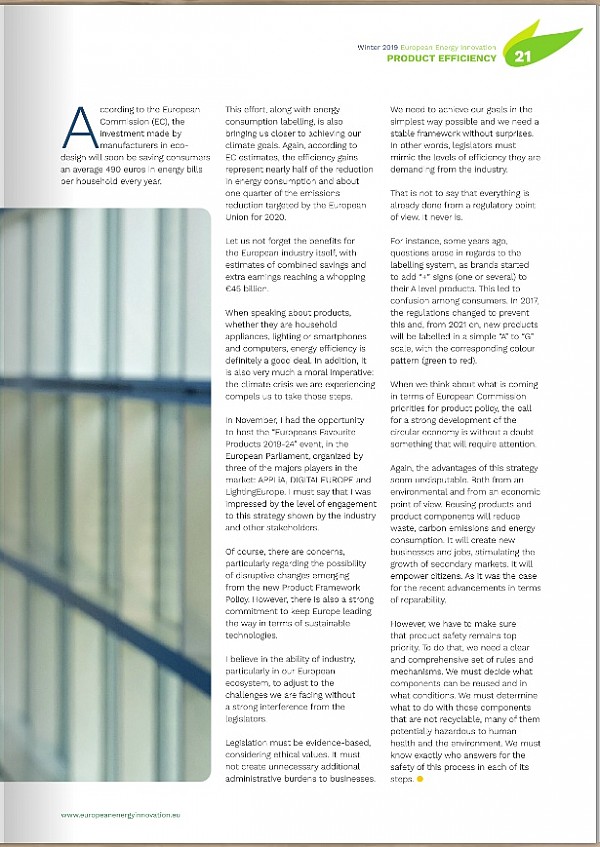Imprensa Product policy efficiency is a good deal
According to the European Commission (EC), the investment made by manufacturers in ecodesign will soon be saving consumers an average 490 euros in energy bills per household every year.
This effort, along with energy consumption labelling, is also bringing us closer to achieving our climate goals. Again, according to EC estimates, the efficiency gains represent nearly half of the reduction in energy consumption and about one quarter of the emissions reduction targeted by the European Union for 2020.
Let us not forget the benefits for the European industry itself, with estimates of combined savings and extra earnings reaching a whopping €45 billion.
When speaking about products, whether they are household appliances, lighting or smartphones and computers, energy efficiency is definitely a good deal. In addition, it is also very much a moral imperative: the climate crisis we are experiencing compels us to take those steps.
In November, I had the opportunity to host the “Europeans Favourite Products 2019-24” event, in the European Parliament, organized by three of the majors players in the market: APPLiA, DIGITALEUROPE and LightingEurope. I must say that I was impressed by the level of engagement to this strategy shown by the industry and other stakeholders.
Of course, there are concerns, particularly regarding the possibility of disruptive changes emerging from the new Product Framework Policy. However, there is also a strong commitment to keep Europe leading the way in terms of sustainable technologies.
I believe in the ability of industry, particularly in our European ecosystem, to adjust to the challenges we are facing without a strong interference from the legislators.
Legislation must be evidence-based, considering ethical values. It must not create unnecessary additional administrative burdens to businesses. We need to achieve our goals in the simplest way possible and we need a stable framework without surprises. In other words, legislators must mimic the levels of efficiency they are demanding from the industry.
That is not to say that everything is already done from a regulatory point of view. It never is. For instance, some years ago, questions arose in regards to the labelling system, as brands started to add “+” signs (one or several) to their A level products. This led to confusion among consumers. In 2017, the regulations changed to prevent this and, from 2021 on, new products will be labelled in a simple “A” to “G” scale, with the corresponding colour pattern (green to red).
When we think about what is coming in terms of European Commission priorities for product policy, the call for a strong development of the circular economy is without a doubt something that will require attention.
Again, the advantages of this strategy seem undisputable. Both from an environmental and from an economic point of view. Reusing products and product components will reduce waste, carbon emissions and energy consumption. It will create new businesses and jobs, stimulating the growth of secondary markets. It will empower citizens. As it was the case for the recent advancements in terms of reparability.
However, we have to make sure that product safety remains top priority. To do that, we need a clear and comprehensive set of rules and mechanisms. We must decide what components can be reused and in what conditions. We must determine what to do with those components that are not recyclable, many of them potentially hazardous to human health and the environment. We must know exactly who answers for the safety of this process in each of its steps.

